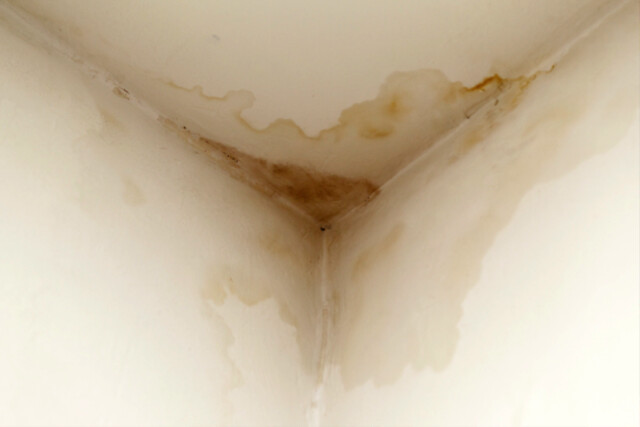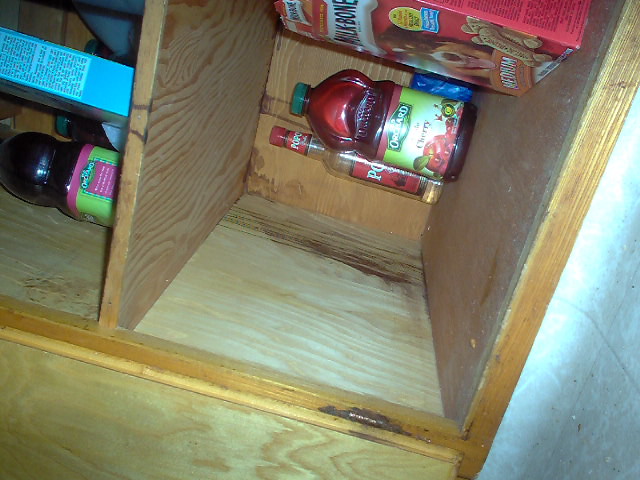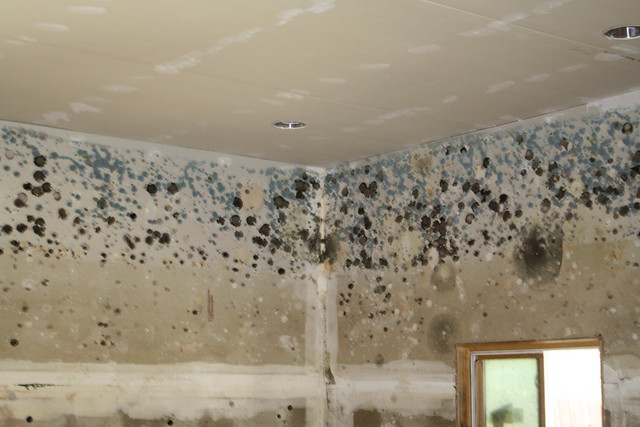Before you start thinking about Mold Symptoms, the odds are that if you have a mold problem, you’ll know it. Those black spots growing on your wall aren’t supposed to be there, and if you see them, it’s time to take action. Long before you see them though, you’ll probably smell the growth of the mold colony. People describe the smell of an active mold colony in different ways, but the most common descriptions include things like rotting wood, rotting paper, or wet, nasty, sweat-soaked socks. In any case, it’s a pretty unforgettable odor, and one you’ll know when it hits your nose.
Some people, however, are just especially sensitive to mold spores, and if someone in your home has started exhibiting any of the symptoms we’ll describe below, it could be the case that they’re serving as the proverbial canary in the coal mine – warning you of bigger problems to come if something isn’t done immediately.
Symptoms – Common Household Molds
Unfortunately, our bodies typically react to mold the same way we react to anything we’re allergic to. The vast majority of mold species cause symptoms like this in most of the people they impact. One way or another, it comes down to inflammation. Some people find that they start inexplicably breaking out into hives or get some kind of minor rash on their skin.
For others, it’s the classic runny nose and watery eyes, along with coughing or sneezing. Headaches are another common symptom, but again, these are the exact same symptoms that people who are allergic to cats, or dog fennel, or pretty much anything else exhibit, so it can be hard to tell. Is your son or daughter sneezing because he/she is allergic to cats, or because you’ve got a mold problem? Note that these problems are much more likely to occur in people whose immune systems are already compromised by some other illness, who have other allergies (which makes it even harder to get to the root cause) or who have conditions of the lung like asthma or COPD. For these people, mold spores can quickly move from minor inconvenience to serious health issue.
Symptoms – Food Borne Molds
Some molds grow mostly on foods, and we’ve all done this at some point or another in our lives. We pick up a roll or a slice of bread, pop it into our mouths, and…bleh! That awful, fuzzy, moldy taste hits us like a ton of bricks!

It’s pretty bad, but in the vast majority of cases, eating a small amount of mold like this won’t actually do anything to you unless you’ve already got a weakened immune system, or have a bad allergy problem to begin with. In those cases, it can genuinely make you sick. Here, the most common symptoms are diarrhea, vomiting, and upset or cramping stomach. Generally, these pass when the food works its way out of your system, but sometimes, and for some people the symptoms can linger.
Symptoms – Toxic Molds
There are a very few (less than twenty, all told) mold species that give off toxic chemicals which can have serious health consequences for anyone. Again, if you already have a weakened immune system or an existing allergy or breathing problem like Asthma or COPD, you are much more likely to be impacted by toxic mold spores than other people, but given a long enough exposure time, or a very intense, highly concentrated exposure, these spores can make nearly anyone sick.
Initially the symptoms will mirror those of any other type of mold spore. The typical allergic reaction – watery eyes, itchy skin, sneezing and coughing. If left unchecked, however, these symptoms can worsen, manifesting in brain fog, inability to concentrate, and slurred speech. If these symptoms continue to go untreated, and the affected individual continues to be exposed to the toxic spores, they can cause permanent blindness, cancer, coma, and even death, so this is not something to be taken lightly!
So…Is It Mold, Or Isn’t It?
If you, or someone in your family starts exhibiting symptoms, how can you find out what, exactly, is causing it? There are a couple of different approaches here.
The first involves going to your doctor, and here, you’ve got two basic choices. You can have a skin test performed, or a blood test (or both). In the case of a skin test, basically what the doctor does is applies a tiny amount of various allergens to the patient’s skin and observes the reaction. If any adverse reactions are noted, that person is allergic to the thing(s) he or she had a response to.
Blood tests accomplish the same thing, trading one type of temporary discomfort for another. Neither test, however, is perfect. After all, in both cases, the doctor and lab technicians are testing for a specific series of substances. If the substance that’s impacting you or your loved one isn’t on the list, it won’t show up in the test results either way. Even so, these tests provide definitive answers in more than 75% of cases, which makes them pretty cost-effective, reliable means of arriving at an answer.
But what if the tests don’t reveal anything?
Well, in that case, it’s time to move to option two – home testing. Here, the goal is to find out what kinds of things you might have in your home’s air that could be causing an adverse reaction. Again, two major options to consider. The first is calling on a professional Air Quality or Mold Remediation Specialist to come check the quality of your air and measure the various pollutants found, and yes, most homes have a certain level of pollutants in the air. It could be mostly dust mites and pet dander, or the odd mold spore, or something else.
The point is, these experts can get to the bottom of it and give you a definitive answer. This approach does come with one rather serious drawback, however – it is expensive! The services of such a professional will set you back somewhere in the neighborhood of $300-$400, which is a hefty chunk of change in most people’s books. The good news is, there’s an alternative. You can buy a home testing kit and do it yourself.
Now granted, the home testing kits aren’t without their drawbacks and limitations, but it is a cost effective way to see if you have a mold problem, and find out what species of mold is causing the issue. Once you know that, you can start taking steps to correct the issue.
Treating Mold Symptoms
Most mold symptoms are easily treated with over the counter medications. Any drug that’s used to treat allergies will have a positive impact on symptoms caused by common household and most food-borne molds, so look for things like Claritin, Allegra, Alavert and Zyrtec. Any of these should serve the purpose.
In the case of food-borne mold, supplementing these with a dose of Pepto Bismol should see you through until the food works its way out of your system. It’s an unpleasant taste, but no more so than the mold you accidentally ate to begin with!
If these things prove ineffective, and they might for people who are especially sensitive to mold, as we mentioned before, then you should immediately see your doctor. They can give a variety of anti-allergy shots, which provide the next level of protection. This, however, should not be considered your first line of defense – always try the over the counter solutions first!
Unfortunately, the good news stops there. If you, or someone in your family is exhibiting symptoms of toxic mold infection, you’re going to need to see your doctor right away. There are no quick and easy over the counter solutions for that.
Next Steps
Before you call the professionals, you must understand that it’s one thing to treat the symptoms, but that’s really only applying a Band-Aid to the problem. Those symptoms are going to linger until you address the root cause, which is invariably going to involve getting rid of the mold spores in your home that are causing the problem.
Once again, there are two paths you can take. You can either go the Do it Yourself route, or you can call in the pros. The do it yourself route involves some time and elbow grease. You’ll need to spend some time making some homemade mold killing solutions, and probably invest in a dehumidifier and an air purifier. The former helps ensure that the conditions that make mold infestation possible are removed from the equation by extracting the excess moisture from the air of your home, while the latter traps any airborne mold spores that might be lurking in the air of your living spaces.
If you go the route of calling in a professional, you don’t have to do much of anything beyond setting the appointment. The experts will come in and get rid of the problem for you, but you’ll pay a premium for the service. These kinds of jobs start at several hundred dollars, and can run into the thousands of dollars, which can be a pretty big financial burden for many.
The bottom line is that mold symptoms are nothing to sneeze at (pun intended!) – they can lead to serious health problems if left untreated, and even if they are treated, those symptoms will remain as long as the underlying problem isn’t addressed.
It can be an expensive, time consuming process to completely remove a mold infestation from your home, and even more expensive to invest in the technology you’ll need to keep the infestation from returning to haunt you later, but there’s just no good alternative. If you don’t take action, the problem is only going to get worse over time, until you arrive at a point where there’s just no alternative BUT to take action. The sooner you start responding, the easier it’ll be to rid yourself of the problem once and for all. The good news is, once you’ve fought the initial battle, and gotten the technology in place, barring some unforeseen catastrophe, your chances of seeing a recurrence are minimal.




Leave a Reply